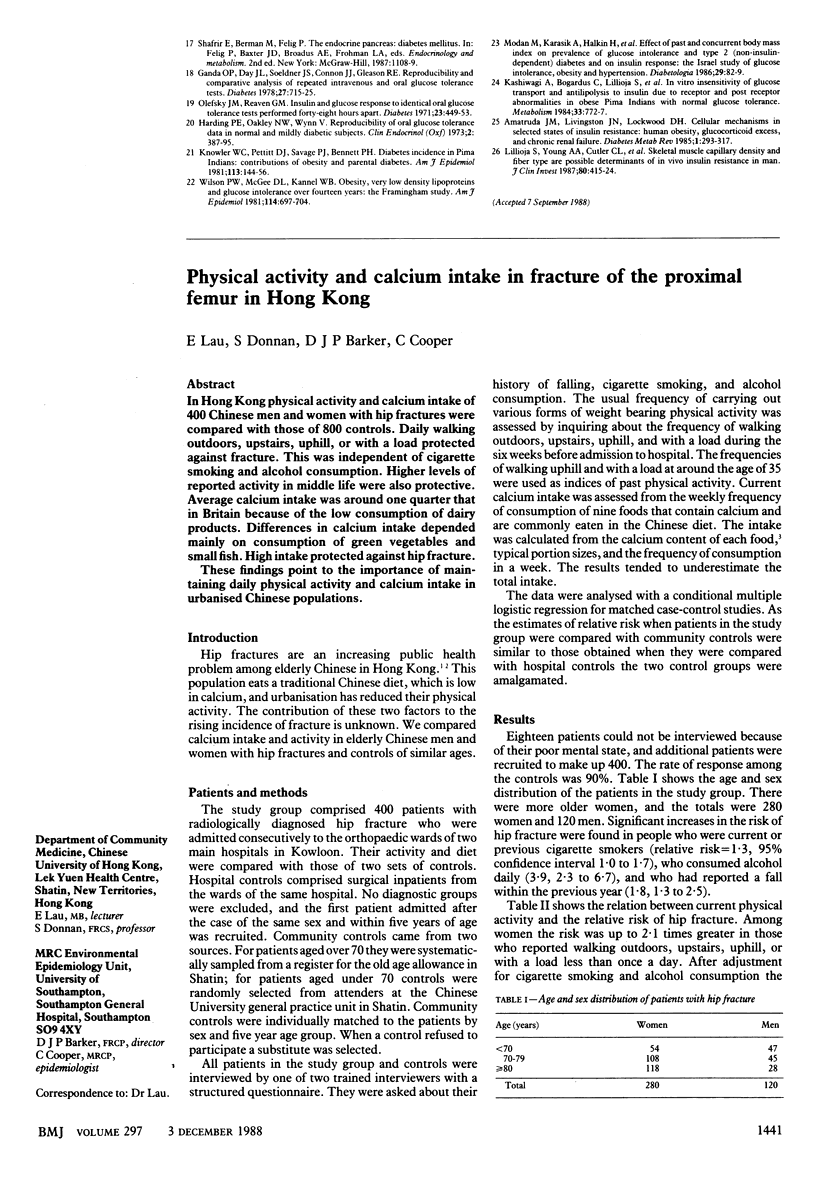Abstract
As part of a continuing epidemiological study of non-insulin dependent diabetes among Pima Indians 154 subjects who had had a transient impairment of glucose tolerance were followed up for 1.2-16.9 (median 5.8) years after their glucose tolerance had returned to normal. Of these, 49 subsequently developed diabetes; 26 subsequently developed impaired glucose tolerance; and 79 had normal glucose tolerance at the last examination. The cumulative incidence of diabetes was 16% and 48% at five and 10 years of follow up respectively, compared with 3% and 8% for a control group of 1245 members of the same population. After adjustment for age, sex, body mass index, and plasma glucose concentration two hours after glucose loading the incidence of diabetes among the subjects who had had transient impaired glucose tolerance was 3.0 times that among the controls (95% confidence interval 2.1 to 4.3). Proportional hazards function analysis indicated that obesity was the most important predictor of subsequent development of diabetes. The results suggest that transient impairment of glucose tolerance indicates, at least in some subjects, a predisposition to diabetes and should not be considered clinically unimportant.
Full text
PDF



Selected References
These references are in PubMed. This may not be the complete list of references from this article.
- Agner E., Thorsteinsson B., Eriksen M. Impaired glucose tolerance and diabetes mellitus in elderly subjects. Diabetes Care. 1982 Nov-Dec;5(6):600–604. doi: 10.2337/diacare.5.6.600. [DOI] [PubMed] [Google Scholar]
- Amatruda J. M., Livingston J. N., Lockwood D. H. Cellular mechanisms in selected states of insulin resistance: human obesity, glucocorticoid excess, and chronic renal failure. Diabetes Metab Rev. 1985;1(3):293–317. doi: 10.1002/dmr.5610010304. [DOI] [PubMed] [Google Scholar]
- Burton B. T., Foster W. R., Hirsch J., Van Itallie T. B. Health implications of obesity: an NIH Consensus Development Conference. Int J Obes. 1985;9(3):155–170. [PubMed] [Google Scholar]
- Ganda O. P., Day J. L., Soeldner J. S., Connon J. J., Gleason R. E. Reproducibility and comparative analysis of repeated intravenous and oral glucose tolerance tests. Diabetes. 1978 Jul;27(7):715–725. doi: 10.2337/diab.27.7.715. [DOI] [PubMed] [Google Scholar]
- Harding P. E., Oakley N. W., Wynn V. Reproducibility of oral glucose tolerance data in normal and mildly diabetic subjects. Clin Endocrinol (Oxf) 1973 Oct;2(4):387–395. doi: 10.1111/j.1365-2265.1973.tb01725.x. [DOI] [PubMed] [Google Scholar]
- Jarrett R. J. Do we need IGT? Diabet Med. 1987 Nov-Dec;4(6):544–545. doi: 10.1111/j.1464-5491.1987.tb00927.x. [DOI] [PubMed] [Google Scholar]
- Kashiwagi A., Bogardus C., Lillioja S., Huecksteadt T. P., Brady D., Verso M. A., Foley J. E. In vitro insensitivity of glucose transport and antilipolysis to insulin due to receptor and postreceptor abnormalities in obese Pima Indians with normal glucose tolerance. Metabolism. 1984 Aug;33(8):772–777. doi: 10.1016/0026-0495(84)90221-x. [DOI] [PubMed] [Google Scholar]
- Keen H., Jarrett R. J., McCartney P. The ten-year follow-up of the Bedford survey (1962-1972): glucose tolerance and diabetes. Diabetologia. 1982 Feb;22(2):73–78. doi: 10.1007/BF00254832. [DOI] [PubMed] [Google Scholar]
- Knowler W. C., Bennett P. H., Hamman R. F., Miller M. Diabetes incidence and prevalence in Pima Indians: a 19-fold greater incidence than in Rochester, Minnesota. Am J Epidemiol. 1978 Dec;108(6):497–505. doi: 10.1093/oxfordjournals.aje.a112648. [DOI] [PubMed] [Google Scholar]
- Knowler W. C., Pettitt D. J., Savage P. J., Bennett P. H. Diabetes incidence in Pima indians: contributions of obesity and parental diabetes. Am J Epidemiol. 1981 Feb;113(2):144–156. doi: 10.1093/oxfordjournals.aje.a113079. [DOI] [PubMed] [Google Scholar]
- Lillioja S., Young A. A., Culter C. L., Ivy J. L., Abbott W. G., Zawadzki J. K., Yki-Järvinen H., Christin L., Secomb T. W., Bogardus C. Skeletal muscle capillary density and fiber type are possible determinants of in vivo insulin resistance in man. J Clin Invest. 1987 Aug;80(2):415–424. doi: 10.1172/JCI113088. [DOI] [PMC free article] [PubMed] [Google Scholar]
- Modan M., Karasik A., Halkin H., Fuchs Z., Lusky A., Shitrit A., Modan B. Effect of past and concurrent body mass index on prevalence of glucose intolerance and type 2 (non-insulin-dependent) diabetes and on insulin response. The Israel study of glucose intolerance, obesity and hypertension. Diabetologia. 1986 Feb;29(2):82–89. doi: 10.1007/BF00456115. [DOI] [PubMed] [Google Scholar]
- Olefsky J. M., Reaven G. M. Insulin and glucose responses to identical oral glucose tolerance tests performed forty-eight hours apart. Diabetes. 1974 May;23(5):449–453. doi: 10.2337/diab.23.5.449. [DOI] [PubMed] [Google Scholar]
- Riccardi G., Vaccaro O., Rivellese A., Pignalosa S., Tutino L., Mancini M. Reproducibility of the new diagnostic criteria for impaired glucose tolerance. Am J Epidemiol. 1985 Mar;121(3):422–429. doi: 10.1093/oxfordjournals.aje.a114014. [DOI] [PubMed] [Google Scholar]
- Sartor G., Scherstén B., Carlström S., Melander A., Nordén A., Persson G. Ten-year follow-up of subjects with impaired glucose tolerance: prevention of diabetes by tolbutamide and diet regulation. Diabetes. 1980 Jan;29(1):41–49. doi: 10.2337/diab.29.1.41. [DOI] [PubMed] [Google Scholar]
- Wilson P. W., McGee D. L., Kannel W. B. Obesity, very low density lipoproteins, and glucose intolerance over fourteen years: The Framingham Study. Am J Epidemiol. 1981 Nov;114(5):697–704. doi: 10.1093/oxfordjournals.aje.a113240. [DOI] [PubMed] [Google Scholar]


